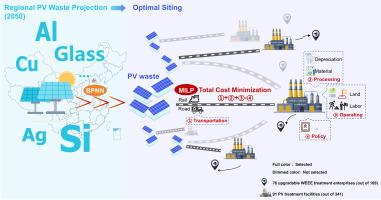Optimal siting of photovoltaic waste treatment facilities in China: A mixed-integer linear programming approach
IF 11.2
1区 社会学
Q1 ENVIRONMENTAL STUDIES
引用次数: 0
Abstract
Facing the first wave of large-scale photovoltaic (PV) module decommissioning as the global leader in installed capacity, China urgently requires efficient nationwide PV waste recycling. This study projects regional PV waste volumes by 2050 using a Genetic Algorithm-optimized Backpropagation Neural Network (BPNN), revealing a distinct ring-shaped spatial distribution. Integrating multi-source data (transport, processing, operation, and other parameters), a Mixed-Integer Linear Programming (MILP) model is developed to minimize total costs and optimize the national siting of PV waste treatment facilities, comparing results with existing China-certified Waste Electrical and Electronic Equipment (WEEE) treatment enterprises. The analysis identifies 91 optimal locations for PV waste treatment facilities, concentrated in the Northwest and North China waste-intensive zone, utilizing rail for cost-effective transportation. Some large hubs achieve significant economies of scale, while smaller local plants face scale limitations despite cost benefits. Although 76 of the current 109 certified WEEE treatment enterprises can potentially upgrade for PV waste treatment, facility shortages may persist in some regions, necessitating mobile collection and temporary transfer solutions. Therefore, to address the research gap in sub-provincial PV waste generation and transport networks, this study establishes a decision-support framework aimed at achieving efficient, economical, and sustainable recycling by projecting China's future waste distribution pattern and optimizing the siting of treatment facilities for 2050.

中国光伏废弃物处理设施的优化选址:一种混合整数线性规划方法
作为装机容量全球领先的国家,面对第一波大规模光伏组件退役浪潮,中国迫切需要在全国范围内实现高效的光伏废弃物回收。本研究使用遗传算法优化的反向传播神经网络(BPNN)预测了到2050年区域光伏废弃物量,揭示了一个独特的环形空间分布。综合多源数据(运输、加工、运营等参数),建立了混合整数线性规划(MILP)模型,以最小化总成本并优化光伏废弃物处理设施的全国选址,并将结果与现有的中国认证的废旧电子电气设备(WEEE)处理企业进行比较。该分析确定了91个光伏废物处理设施的最佳地点,集中在西北和华北废物集中地区,利用铁路进行成本效益高的运输。一些大型中心实现了显著的规模经济,而较小的当地工厂尽管具有成本效益,但仍面临规模限制。虽然目前109家获得认证的报废电子电气设备处理企业中有76家有可能升级光伏废弃物处理,但在一些地区,设施短缺可能会持续存在,需要移动收集和临时转移解决方案。因此,为了解决省级以下光伏废弃物产生和运输网络的研究缺口,本研究通过预测中国未来废弃物分布格局和优化2050年处理设施选址,建立了一个旨在实现高效、经济和可持续回收的决策支持框架。
本文章由计算机程序翻译,如有差异,请以英文原文为准。
求助全文
约1分钟内获得全文
求助全文
来源期刊

Environmental Impact Assessment Review
ENVIRONMENTAL STUDIES-
CiteScore
12.60
自引率
10.10%
发文量
200
审稿时长
33 days
期刊介绍:
Environmental Impact Assessment Review is an interdisciplinary journal that serves a global audience of practitioners, policymakers, and academics involved in assessing the environmental impact of policies, projects, processes, and products. The journal focuses on innovative theory and practice in environmental impact assessment (EIA). Papers are expected to present innovative ideas, be topical, and coherent. The journal emphasizes concepts, methods, techniques, approaches, and systems related to EIA theory and practice.
 求助内容:
求助内容: 应助结果提醒方式:
应助结果提醒方式:


